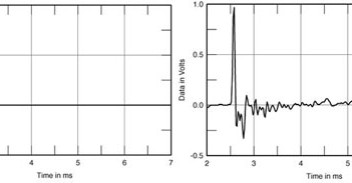An IR is just a sound file like any music you may have. The WAVE file format is used because there is no compression. No compression/decompression means the file is perfect and not messed up just by saving. IRs are almost always MONO.
Any Audio Editing software will have EQ options. I always use Goldwave (my personal favorite). But there are many many options.
WHAT IS AN IMPULSE RESPONSE

When you play an impulse(Left) thru a speaker, the impulse is turned into a softer spike followed by a lot of oscillations (right). The oscillations are the effect of the speaker trying to move, its vibrations, and vibrations of the cabinet itself.
The image on the right is what your IR waveform will look like in an audio editing program. Notice the sharp spike and small vibrations after. Also notice there is only a small amount of time before the impulse starts. This delay creates a delay or lag in the playback of your IR. You do not want a lot of time here. Smaller is better. This delay may get removed when the Kemper converts the IR to a CAB, but smaller is still better.
1) Make a copy of the IR/WAVE file.
2) Open the copy IR/WAVE file in an audio editor.
3) Apply an EQ to it just like you would music.
4) Save the edited IR/WAVE file.
After the EQ, make sure the IR still has a spike to it. Some filters destroy the phase response of the frequencies. You will get best results if you do not destroy the phase response. Try a different filter EQ in that software.
The IR usually has a spike followed by small ripples. This spike sort of determines how loud the IR is. If you edit an IR and it gets all smeared, the spike disappears and the resulting IR may be much louder than the original. Especially if you NORMALIZE or MAXIMIZE the volume after editing.
Goldwave note: Spectrum Filters works good in GW. Graphic EQ will destroy the phase and mess up the waveform.
TRICKS
1) In your audio editor, change the pitch of the IR. This lets you make the speaker sound larger or smaller. Larger (lower pitch) usually works best. You will get a thicker heavier cabinet sound.
2) Apply compression to the IR to alter the frequency response and alter volume.
Goldwave note: The default Pitch Change effect works great. Do not select Preserve Tempo, which uses FFT and can mess up the IR. Or experiment and use the FFT method, but you will need to edit the results because the spike can get moved.
DEEP DIVE
The IR is a plot of the sound echoes of the original impulse. If the IR was made very long in time, it could be used as a reverb. In fact, a guitar IR is basically is a very fast reverb simulation. The longest IR files the Kemper uses are 2048 samples. At 44.1 kHz that is a very short amount of time. Approx 47 mS. Not enough time to make a cool reverb. But you could make a fast slapback echo 
Since the IR is a plot of the echoes, the IR is reproduced in software by simply multiplying each guitar sample by the IR. In essence playing back all 2048 echoes at once. Since the echoes are out of time from the original pulse, they phase cancel and create a time based EQ. That is why you do not want to apply an audio editor EQ that smears the phase response. It may alter the final IR sound a lot.
CAVEAT EMPTOR
My brain is small. I know just enough to be dangerous. Read what smart people have said about IRs, because some of what I posted is probably wrong.
